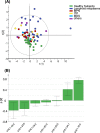Serum GM3(d18:1-16:0) and GM3(d18:1-24:1) levels may be associated with lymphoma: An exploratory study with haematological diseases
- PMID: 31004109
- PMCID: PMC6474875
- DOI: 10.1038/s41598-019-42817-3
Serum GM3(d18:1-16:0) and GM3(d18:1-24:1) levels may be associated with lymphoma: An exploratory study with haematological diseases
Abstract
GM3 (monosialodihexosylganglioside) is a type of ganglioside, which is a molecule composed of ceramide and oligosaccharide containing one or more sialic acids. Since GM3 is abundantly expressed in blood cells, we investigated the association between GM3 molecular species and haematological diseases. We measured the serum levels of seven GM3 molecular species in subjects with various haematological diseases (n = 52) and healthy subjects (n = 24) using a liquid chromatography tandem-mass spectrometry technique as an exploratory study. In all the subjects with haematological diseases, GM3(d18:1-16:0) were inversely correlated with the erythrocytes counts. Regarding the difference in serum GM3 molecular species levels among each haematological diseases and healthy subjects, the levels of GM3(d18:1-16:0) and GM3(d18:1-24:1) were higher in the lymphoid neoplasm group than healthy subjects. Principal component analyses also revealed that the GM3(d18:1-16:0) and GM3(d18:1-24:1) levels were significant contributing factors for discriminating the lymphoid neoplasm group. Moreover, in the lymphoid neoplasm group, the GM3(d18:1-16:0) levels were significantly and positively correlated with the levels of C-reactive protein, soluble interleukin-2 receptor, and lactate dehydrogenase. In conclusion, in our exploratory study with haematological diseases, GM3 molecular species showed different distribution among disease groups, and serum GM3(d18:1-16:0) and GM3(d18:1-24:1) might be associated with lymphoma.
Conflict of interest statement
The authors declare no competing interests.
Figures




Similar articles
-
Perioperative changes in ganglioside monosialodihexosylganglioside (GM3) molecular species for benign prostatic hyperplasia: a preliminary report.Transl Androl Urol. 2024 Jan 31;13(1):104-108. doi: 10.21037/tau-23-414. Epub 2024 Jan 15. Transl Androl Urol. 2024. PMID: 38404559 Free PMC article.
-
Identification of Ganglioside GM3 Molecular Species in Human Serum Associated with Risk Factors of Metabolic Syndrome.PLoS One. 2015 Jun 23;10(6):e0129645. doi: 10.1371/journal.pone.0129645. eCollection 2015. PLoS One. 2015. PMID: 26102277 Free PMC article.
-
Gangliosides profiling in serum of breast cancer patient: GM3 as a potential diagnostic biomarker.Glycoconj J. 2019 Oct;36(5):419-428. doi: 10.1007/s10719-019-09885-z. Epub 2019 Jul 11. Glycoconj J. 2019. PMID: 31297734
-
GM3 and cancer.Glycoconj J. 2015 Feb;32(1-2):1-8. doi: 10.1007/s10719-014-9572-4. Epub 2015 Jan 23. Glycoconj J. 2015. PMID: 25613425 Review.
-
Pathophysiological Significance of GM3 Ganglioside Molecular Species With a Particular Attention to the Metabolic Syndrome Focusing on Toll-Like Receptor 4 Binding.Front Mol Biosci. 2022 May 30;9:918346. doi: 10.3389/fmolb.2022.918346. eCollection 2022. Front Mol Biosci. 2022. PMID: 35712350 Free PMC article. Review.
Cited by
-
Sphingolipids and Lymphomas: A Double-Edged Sword.Cancers (Basel). 2022 Apr 19;14(9):2051. doi: 10.3390/cancers14092051. Cancers (Basel). 2022. PMID: 35565181 Free PMC article. Review.
-
Differential lipidomics of HK-2 cells and exosomes under high glucose stimulation.Int J Med Sci. 2022 Jan 24;19(2):393-401. doi: 10.7150/ijms.67326. eCollection 2022. Int J Med Sci. 2022. PMID: 35165524 Free PMC article.
-
Chemical synthesis and immunological evaluation of cancer vaccines based on ganglioside antigens and α-galactosylceramide.RSC Med Chem. 2024 Jun 21;15(8):2718-2728. doi: 10.1039/d4md00387j. eCollection 2024 Aug 14. RSC Med Chem. 2024. PMID: 39149099 Free PMC article.
-
Perioperative changes in ganglioside monosialodihexosylganglioside (GM3) molecular species for benign prostatic hyperplasia: a preliminary report.Transl Androl Urol. 2024 Jan 31;13(1):104-108. doi: 10.21037/tau-23-414. Epub 2024 Jan 15. Transl Androl Urol. 2024. PMID: 38404559 Free PMC article.
References
-
- Hanai N, Dohi T, Nores GA, Hakomori S. A novel ganglioside, de-N-acetyl-GM3 (II3NeuNH2LacCer), acting as a strong promoter for epidermal growth factor receptor kinase and as a stimulator for cell growth. J. Biol. Chem. 1988;263:6296–6301. - PubMed
-
- Nakamura M, et al. Ganglioside GM3 can induce megakaryocytoid differentiation of human leukemia cell line K562 cells. Cancer Res. 1991;51:1940–1945. - PubMed
Publication types
MeSH terms
Substances
LinkOut - more resources
Full Text Sources
Medical
Research Materials

